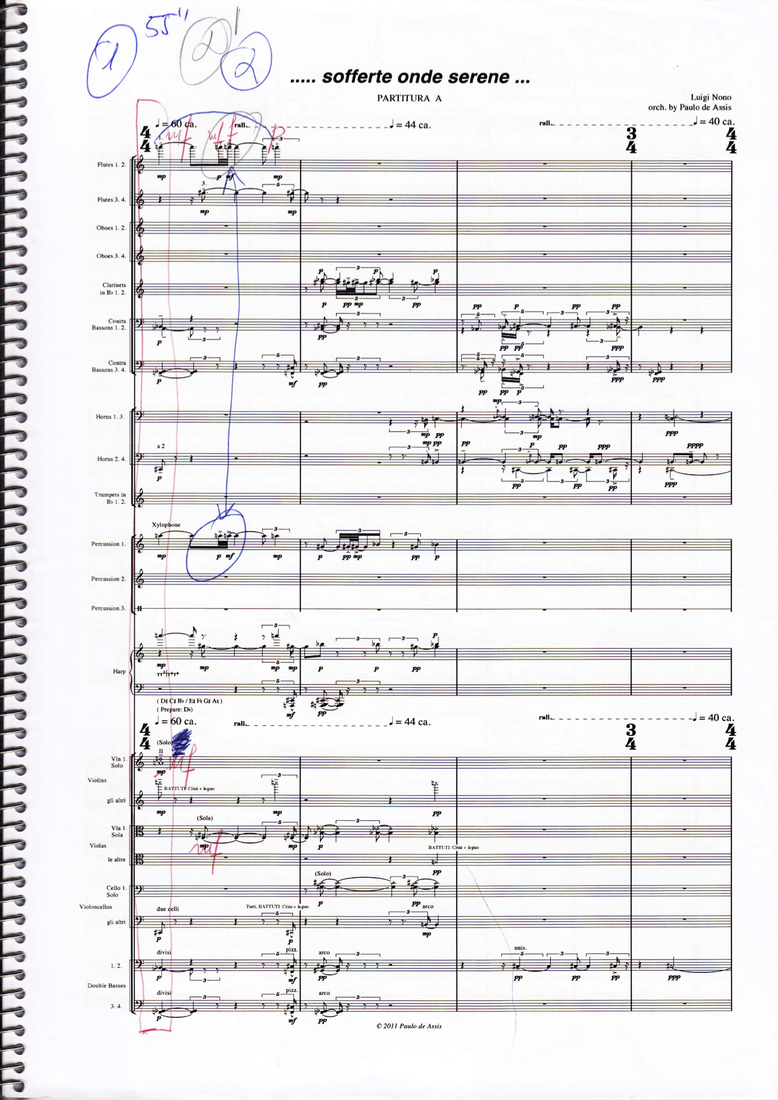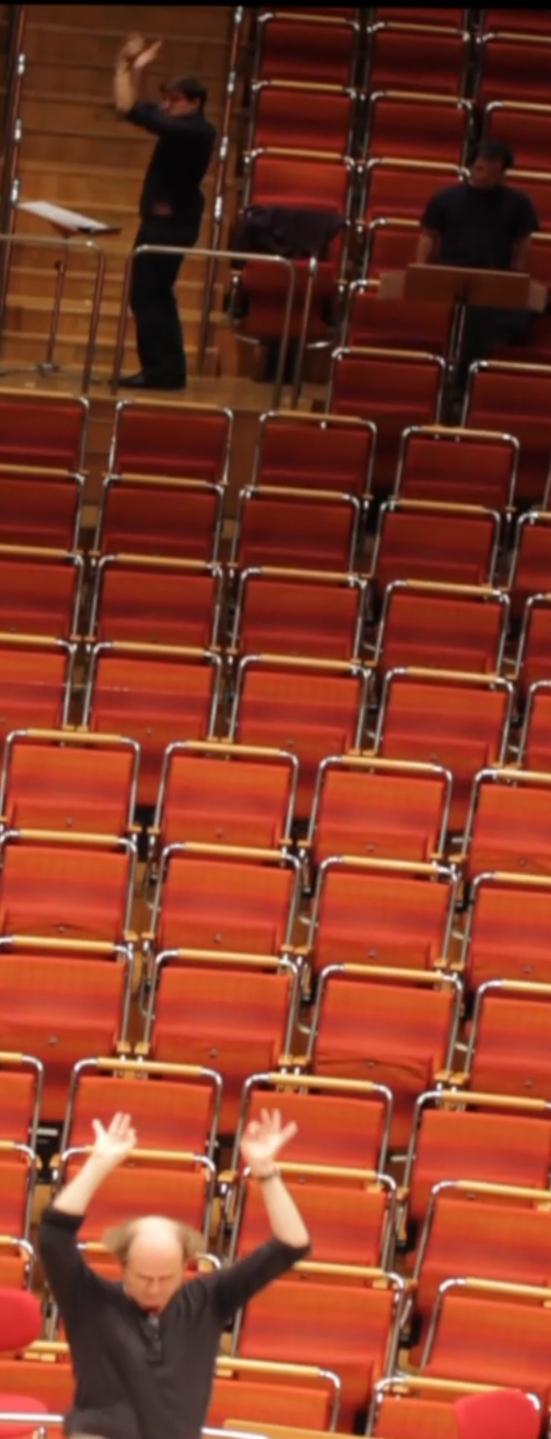Module 6 contains a short text on the reasons for and the goals and processes of the transformation of …..sofferte onde serene… for four orchestral groups, and a video documentation made by Juan Parra Cancino of short excerpts of the rehearsals with the WDR Symphonieorchester Köln directed by Peter Rundel and Léo Warinsky.
Exploring multi-temporalities.
A Transformation of Luigi Nono’s .....sofferte onde serene...*
In …..sofferte onde serene… (1974–77) for piano and tape – written with and for Maurizio Pollini – several new elements emerge in the musical language of Nono, including new modes of organising ‘multi-temporalities’, with the piano and the tape following different paths on the same journey. As a result, renderings of this piece involve various degrees of uncertainty and unpredictability of sonic combinations – an aspect that is reinforced by the use of ‘shadow’ sounds, similar sonorities that come sometimes from the piano, sometimes from the tape, and that generate a perceptual (con)fusion for the listener. The transcription of this piece for orchestra in four groups here presented aims at further exploring and developing specific practices of multi-temporality, focussing on the collaborative creative performance, where two conductors, reading two fully independent scores, have to develop a sense of a ‘chamber musically oriented’ performance. This orchestration points to new modes of exposing and performing multi-temporal pieces.
After dozens of performances of …..sofferte onde serene… (between 1995 and 2012) as a pianist, a doctorial thesis on it (1999–2003), and the realisation of a critical edition of its score (2009, supported by the Orpheus Institute Ghent), the author of this exposition decided to revisit this work from a completely new angle, making an orchestration both of the piano part and of the tape. To further explore and develop specific practices of multi-temporality, two completely different scores were written down: one for the orchestra (onstage), playing what was originally the piano part; another for three groups (positioned around the audience), performing on acoustic instruments what was originally the magnetic tape (see Fig. 1, Fig. 2). The two conductors – reading two completely different and partially independent scores – have to develop a sense of a chamber musically oriented performance while conducting more than sixty musicians. The focus is thus placed on the collaborative creative performance. Every rehearsal and every concert rendering will be concretely different, while retaining the basic musical structure. An aspect that reinforces the fundamental idea behind this orchestration is the concept of ‘differential repetition’, inspired by Gilles Deleuze’s philosophy of ‘permanent becoming’ (2001 [1968]). Beyond the flexible coordination of temporalities established by the two conductors, the individual orchestral musicians have certain degrees of freedom, especially in the many notated suspensions – spots where their creativity is ‘locally’ demanded. In such moments, the conductor stops conducting for a moment and gives space to the individuals.
Another crucial element of the original composition concerns the spatialisation of the tape projection. According to the evidence of the sketches and the LP produced by Deutsche Grammophon (with Maurizio Pollini), Nono composed a stereophonic tape with some sections in mono. Sections 1, 4, and 5 were in stereo, whereas the central sections, 2 and 3, were in mono. This means that the return of the sound materials from section 1 in section 4 coincided also with a reopening of the acoustic horizon – from monophony to stereophony. This nuance is lost in the commercialised edition of the piece, given that the tape which accompanies the score is completely monophonic. In my orchestration (as in my reconstruction of the tape), I bring it back to life (Fig. 3): sections 1 and 4 are played by the two external groups (Left and Right), while sections 2 and 3 are played by the centrally positioned group. For the last section all groups play together. Table 2 summarises this aspect:
|
|
Bars in the score |
Original tape |
Orchestral groups |
|
1. |
1–25 |
Stereo |
Left & Right |
|
2. |
26–49 |
Mono |
Front |
|
3. |
50–101 |
Mono |
Front |
|
4. |
102–137 |
Stereo |
Left & Right |
|
5. |
138–155 |
Stereo |
All |
Table 2. Luigi Nono/Paulo de Assis …..sofferte onde serene… for four orchestral groups.
This orchestration of …..sofferte onde serene… was commissioned by the WDR Cologne and premiered on 9 November 2012 at the Kölner Philharmonie with the WDR Sinfonieorchester Köln, conducted by Peter Rundel and Léo Warynski. During the rehearsals several possibilities for vertical coordination between the two musical entities (orchestra onstage and groups in the space) were tried, explored, and worked out. For all the musicians involved in the project this seemed to be an innovative exploration of different temporalities running parallel to one another but coinciding in basic structural points. By reworking a composition that resulted from a collaborative creative practice and that enacted multi-temporalities through the articulation ‘piano–tape’, this orchestration suggests new modes of presenting and performing multi-temporal music pieces: works with multiple, independent, smoothly-varying tempi. In addition to the technical challenges, one must find common musical ground on which the different performers may meet despite their lack of a unifying tempo. These concrete artistic investigations – where the practice of art functions as a research tool, may lead to new kinds of collaborative creative practices and to extended collaborative performing practices.
* A reduced version of this text (Module 1 and Module 6) was published as Assis (2013).
References
Assis, Paulo de. 2006. Luigi Nonos Wende: Zwischen Como una ola de fuerza y luz und . . . sofferte onde serene . . ., 2 vols (Hofheim, Germany: Wolke Verlag)
———. 2013. ‘Exploring Multi-Temporalities: An Orchestration of Luigi Nono’s . . . sofferte onde serene . . .’, in Aaron Williamon and Werner Goebl (eds), Proceedings of the International Symposium on Performance Science 2013 (Brussels: European Association of Conservatoires [AEC]), pp. 777–82
Deleuze, Gilles. 2001. Difference and Repetition, trans. by Paul Patton (New York: Columbia University Press, 1994; repr. London: Continuum). First published in French in 1968
Linden, W. (1989). Luigi Nonos Weg zum Streichquartett: Vergleichende Analysen zu seinen Kompositionen Liebeslied, . . . sofferte onde serene . . ., Fragmente-Stille, An Diotima (Kassel: Bärenreiter)
Nono, Luigi. 1977. . . . sofferte onde serene . . . (Milan: Ricordi), 2nd ed. published 1992.
Stenzl, Jürg (ed.). 1975. Luigi Nono: Texte, Studien zu seiner Musik (Zürich: Atlantis)
7–9 November 2012, Cologne Philharmonic Hall
WDR Sinfonieorchester Köln
Peter Rundel and Léo Warinsky, conductors.






